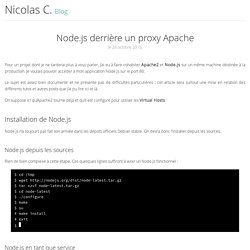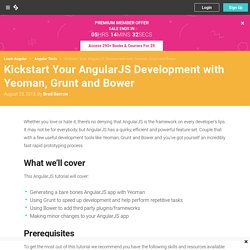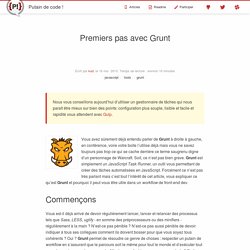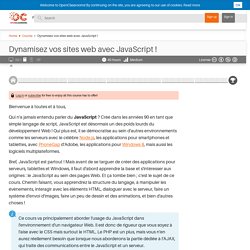

Feathers. Sails. Sequelize. Sendinblue. Search Engine - tags. Advanced Geospatial Analysis. Apache and Node.js on the Same Server. Node.js derrière un proxy Apache. Pour un projet dont je ne tarderai plus à vous parler, j’ai eu à faire cohabiter Apache2 et Node.js sur un même machine déstinée à la production.

Je voulais pouvoir accéder à mon application Node.js sur le port 80. Le sujet est assez bien documenté et ne présente pas de difficultés particulières ; cet article sera surtout une mise en relation des différents tutos et autres posts que j’ai pu lire ici et là. On suppose ici qu’Apache2 tourne déjà et qu’il est configuré pour utiliser les Virtual Hosts. Setup an Eclipse Run External Tool Configuration for Grunt. I use Eclipse along with the Aptana plugin to develop web applications and have been for a long time.

I started using Eclipse because I loved the fact that it provides a full feature Integrated Development Environment (IDE) framework that, through the use of plugins, supports multiple programing languages. At the time I started using it I wanted to learn one IDE that would fulfill developing in multiple languages. To that extent, Eclipse has lived up to it. I have used it to develop Java, Perl, Javascript, CSS, HTML, BrightScript (for my Roku) and will, very soon, use it to develop with Rails. Installing Node.js via package manager. Des applications ultra-rapides avec Node.js. MongoDB, Express, Angularjs Node.js powered fullstack web framework.
Kickstart Your AngularJS Development with Yeoman, Grunt and Bower. Whether you love or hate it, there’s no denying that AngularJS is the framework on every developer’s lips.

It may not be for everybody, but AngularJS has a quirky, efficient and powerful feature set. Couple that with a few useful development tools like Yeoman, Grunt and Bower and you’ve got yourself an incredibly fast rapid prototyping process. What we’ll cover This AngularJS tutorial will cover: Generating a bare bones AngularJS app with YeomanUsing Grunt to speed up development and help perform repetitive tasksUsing Bower to add third party plugins/frameworksMaking minor changes to your AngularJS app Prerequisites To get the most out of this tutorial we recommend you have the following skills and resources available: A terminal and basic knowledge of the command lineNodeJS and NPM installedFundamental JS, CSS and HTML knowledge Files You can find a repo of this tutorial project here.
Let’s get started yo! Alright, let’s get this thing underway. Npm install -g yo grunt-cli bower Yeoman yo angular. Le framework Express.js. Grunt pour ceux qui pensent que Grunt est compliqué. On parle beaucoup de Grunt aujourd'hui, mais les articles disponibles sont souvent abscons et techniques.

Pourtant Grunt n'est pas réservé aux spécialistes, comme le montre cette introduction de Chris Coyier. Par Chris Coyier On donne souvent les conseils suivants aux intégrateurs web : Divisez votre CSS et votre JavaScript en autant de parties que nécessaire, puis concaténez-les pour la version de production de votre site. Compressez votre CSS, minifiez votre JavaScript, pour améliorer la performance de votre site. Il y en aurait encore beaucoup à ajouter, mais voilà déjà quelques basiques. Je suis sûr que vous avez entendu parler de Grunt. Mais soyons clair : Grunt est un de ces nouveaux joujoux à la mode que tous les cool kids utilisent, mais qui à première vue semble étrange et intimidant. Écartons tout de suite quelques malentendus. Premiers pas avec Grunt. Nous vous conseillons aujourd’hui d’utiliser un gestionnaire de tâches qui nous paraît être mieux sur bien des points: configuration plus souple, lisible et facile et rapidité vous attendent avec Gulp.

Vous avez sûrement déjà entendu parler de Grunt à droite à gauche, en conférence, voire votre boite l’utilise déjà mais vous ne savez toujours pas trop ce qui se cache derrière ce terme saugrenu digne d’un personnage de Warcraft. Soit, ce n’est pas bien grave. Grunt est simplement un JavaScript Task Runner, un outil vous permettant de créer des tâches automatisées en JavaScript. Forcément ce n’est pas très parlant mais c’est tout l’intérêt de cet article, vous expliquer ce qu’est Grunt et pourquoi il peut vous être utile dans un workflow de front-end dev. Vous est-il déjà arrivé de devoir régulièrement lancer, lancer et relancer des processus tels que Sass, LESS, uglify - en somme des préprocesseurs ou des minifiers - régulièrement à la main ? Voici un workflow assez classique : $ npm init. Dynamisez vos sites web avec JavaScript !
Bienvenue à toutes et à tous, Qui n'a jamais entendu parler du JavaScript ?

Créé dans les années 90 en tant que simple langage de script, JavaScript est désormais un des poids lourds du développement Web ! Build a real-time polls application with Node.js, Express, AngularJS, and MongoDB. Recently while lecturing on HTML5 to a large group of students, I wanted to poll them and display their voting results, updating in real-time.

I decided to quickly build a polling app for this purpose. I wanted a simple architecture and not too many different languages and frameworks. So I decided to use JavaScript for everything — Node.js and Express for the server-side, MongoDB for the database, and AngularJS for the front-end user interface. “This MEAN stack (Mongo, Express, Angular, Node) may one day surpass the simplicity of the LAMP stack (Linux, Apache, MySQL, PHP) for web application development and deployment.” I chose to use DevOps Services (formerly JazzHub) to manage the source code for my project. MEAN.JS - Full-Stack JavaScript Using MongoDB, Express, AngularJS, and Node.js.
Sass: Sass Basics. Before you can use Sass, you need to set it up on your project.

If you want to just browse here, go ahead, but we recommend you go install Sass first. Go here if you want to learn how to get everything setup.